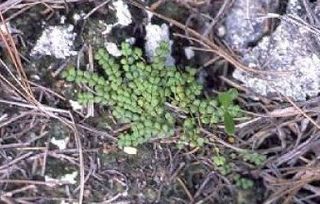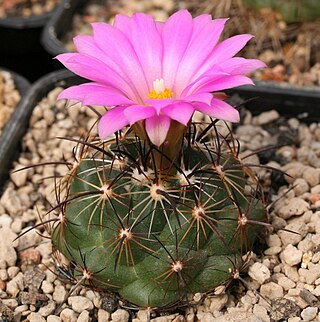
The United States Fish and Wildlife Service is an agency within the United States Department of the Interior dedicated to the management of fish, wildlife, and natural habitats. The mission of the agency is "working with others to conserve, protect, and enhance fish, wildlife, plants and their habitats for the continuing benefit of the American people."

The red-crowned amazon, also known as the red-crowned parrot, green-cheeked amazon or Mexican red-headed parrot, is an endangered amazon parrot native to northeastern Mexico and possibly southern Texas in the United States. A 1994 study estimated wild populations of between 2,000 and 4,300 mature individuals; the IUCN Red List considers it a globally endangered species with a decreasing population. The main threats to the native bird's survival are the illegal export of trapped birds from Mexico to the United States for the pet trade and the destruction of their natural habitat, the lowland forests of northeastern Mexico.

Astrophytum asterias is a species of cactus in the genus Astrophytum, and is native to small parts of Texas in the United States and Mexico. Common names include sand dollar cactus, sea urchin cactus, star cactus and star peyote.

Echinacea laevigata, the smooth purple coneflower, is a federally listed threatened species of plant found in the Piedmont of the eastern United States. Most populations are found on roadsides and other open areas with plenty of sunlight, often on calcium- and magnesium- rich soils.
The World Birding Center is the official title given to a combined nine parks and nature preserves in the Rio Grande Valley region of Texas managed by a partnership of the Texas Parks and Wildlife Department, the United States Fish and Wildlife Service, and the local communities in which the parks reside. The stated mission of the World Birding Center is to "protect native habitat while increasing the understanding and appreciation of the birds and wildlife", with an additional emphasis on promoting local economic development through ecotourism.
Assiminea pecos is a rare species of snail in the family Assimineidae known by the common name Pecos assiminea. It is native to New Mexico and Texas in the United States. Specimens known from Mexico are now treated as members of a separate species, Assiminea cienegensis. The Pecos assiminea was federally listed as an endangered species of the United States in 2005.

The Tamaulipan mezquital is a deserts and xeric shrublands ecoregion in the Southern United States and northeastern Mexico. It covers an area of 141,500 km2 (54,600 sq mi), encompassing a portion of the Gulf Coastal Plain in southern Texas, northern Tamaulipas, northeastern Coahuila, and part of Nuevo León.

Astragalus pycnostachyus var. lanosissimus, the Ventura marsh milk-vetch, is a short-lived, herbaceous perennial in the pea family Fabaceae,

Ambrosia pumila is a rare species of herbaceous perennial plant known by the common names San Diego ragweed and San Diego ambrosia. It is native to far southern California, Baja California, and Baja California Sur. It grows in floodplains and open grasslands in proximity to wetland areas.

Pine Hill Ecological Reserve is a nature reserve of 403 acres (1.63 km2) located due east of Folsom Lake in the Sierra Nevada foothills, in El Dorado County, California. The reserve was established in 1979, and is managed by the Bureau of Land Management.

The Lower Rio Grande Valley National Wildlife Refuge is a 90,788-acre (367.41 km2) National Wildlife Refuge located in the Lower Rio Grande Valley region of southern Texas.
Ambrosia cheiranthifolia is a rare species of flowering plant known by the common names South Texas ambrosia and Rio Grande ragweed. It is native to the coast of South Texas and the Mexican states of Tamaulipas and Coahuila. It occurs in coastal prairie, grassland, and mesquite shrubland habitat. It has declined because its native habitat has been cleared for development, with remaining open savanna invaded by non-native grasses such as buffelgrass. Today there are perhaps 20 populations remaining, but some of these may have very few genetic individuals because the species is clonal, with many cloned plants attached by one rhizome. It is not certain that the plant still exists in Mexico. This is a federally listed endangered species of the United States.

Euphorbia deltoidea is a species of flowering plant endemic to Florida in the United States. The taxonomy of the plant is difficult, with some authorities dividing it into four subspecies and some into three; also, it is frequently listed as a member of the old genus Chamaesyce. One subspecies, ssp. deltoidea, is a federally listed endangered species called deltoid spurge. It is found only in Miami-Dade County. Another subspecies, ssp. adhaerens, is often included with it under the name deltoidea instead of separately, making it difficult to keep count of how many endangered plants there are. This is generally dealt with by placing the "endangered species" label on any taxon within the species that is limited to Miami-Dade County, however many names they may have.

Coryphantha ramillosa is a rare species of cactus known by the common names bunched cory cactus and whiskerbush. It is native to the border region between Texas in the United States and Coahuila in Mexico. Because it was believed to be rare and threatened by a number of processes, it was federally listed as a threatened species of the United States in 1979.

Echinocereus chisoensis is a rare North American species of cactus known by the common name Chisos Mountain hedgehog cactus, native to the Chihuahuan Desert of northern Mexico and the south-central United States.

Erigeron rhizomatus is a rare species of flowering plant in the family Asteraceae known by the common names Zuni fleabane and rhizome fleabane. It is native to western New Mexico and eastern Arizona in the United States. It is a federally listed threatened species.

Hoffmannseggia tenella is a rare species of flowering plant in the legume family known by the common name slender rushpea. It is endemic to Texas, where it is known from only two counties. It persists in small remnants of its gulf coastal prairie habitat. It is a federally listed endangered species of the United States.
Thymophylla tephroleuca is a rare species of flowering plant known by the common names ashy pricklyleaf and ashy dogweed. It is endemic to Texas in the United States, where it occurs in two counties near the Mexican border. It became rare due to the destruction and degradation of its habitat. It is a federally listed endangered species of the United States.
Physaria pallida is a rare species of flowering plant in the mustard family known by the common name white bladderpod. It is endemic to Texas in the United States, where it is known only from San Augustine County. It is federally listed as an endangered species.

Tayshaneta microps, synonym Neoleptoneta microps, is a rare species of spider in the family Leptonetidae known by the common name Government Canyon bat cave spider. It is endemic to Texas in the United States, where it is known to be found in two caves in Bexar County. It is a troglobite, an animal which spends its entire life in caves. It is one of nine Bexar County troglobites which were listed as endangered species in 2000.
















